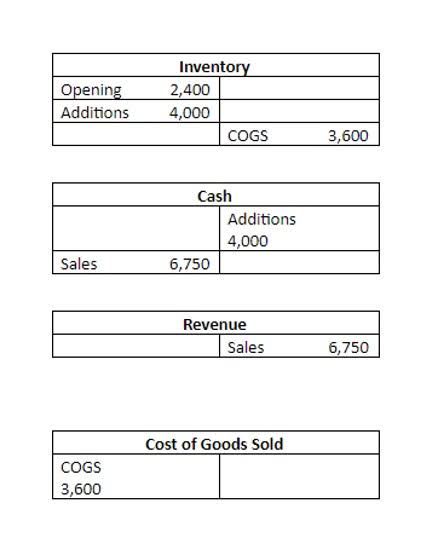
The non-cash working capital as apercent of revenues can be used, in conjunction with expected revenue changeseach period, to estimate projected changes in non-cash working capital overtime. You can obtain the non-cash working capital as a percent of revenues bylooking at the firm�s history or at industry standards. The concept of net working capital has been a foundational element in financial analysis and business strategy for centuries, evolving as businesses have become more complex and the global economy has grown. It serves as a critical indicator of a company’s immediate financial health and operational efficiency.
Why is the Change in Net Working Capital More Important Than the Absolute Value?
- Next, you’ll have to check what your assets and liabilities are for the start of that period and what they currently are.
- We referenced the business cycle earlier; stretching accounts payable and collecting our receivables earlier helps increase our cash available for operations.
- The last three years looks much better, however, with current liabilities increasing faster than current assets.
- The most common examples of operating current assets include accounts receivable (A/R), inventory, and prepaid expenses.
- Figure 10.2 shows the distribution ofnon-cash working capital as a percent of revenues for U.S. firms in January2001.
This is a source of cash, though suppliers may increase prices in response. Ultimately, understanding changes in net working capital is essential for maintaining smooth operations and supporting long-term stability. Paying off long-term obligations requires planning to avoid compromising the funds for running the business. Regularly reviewing your financial condition helps identify potential issues early so you can make informed decisions to keep working capital healthy.
- As the different sections of a financial statement impact one another, changes in working capital affect the cash flow of a company.
- Changes in Net Working Capital (NWC) is an important financial metric used by companies and investors to measure the short-term financial health and efficiency of a company.
- Visit today to learn more and enrol in our investment banking certification course.
- Another name for this is non-cash working capital, because current assets includes cash, which is not used to operate the business and has to be taken out.
- Expanding the business might involve opening new locations, launching new products, or hiring more staff.
- It’s just a sign that the short-term liquidity of the business isn’t that good.
Financial Reconciliation Solutions
They typically include cash in the bank, raw materials and inventory ready for sale, short-term investments, and account receivables (the money customers owe you). For example, if you have $1.35 million in cash, $750,000 worth of products, $58,000 in short-term investments, and $560,000 in accounts receivable, your total current assets would be $2.158 million. Short term working capital is the difference between current assets and current liabilities used in the day to day trading operations of a business. Consequently a change in working capital is any net change in current assets and current liabilities over an accounting period. Net working capital changes reflect shifts in your company’s operating assets and liabilities that impact cash flow and investments. Key factors include expenses, financial statements, and effects on the cash flow statement.
How to Calculate Change in Net Working Capital (NWC)
The net working capital formula is calculated by subtracting the current liabilities from the current assets. Examples of current assets are cash on hand or cash equivalents, and any accounts receivable, marketable securities, and stock inventory that can be converted to cash within one year. Your working capital at any given time is a reliable measurement of your company’s liquidity and financial health. And when you manage your working capital well, you can strike a healthy balance between growth and profitability.
How to Calculate Net Working Capital (NWC)

The reason is that cash and debt are both non-operational and do not directly generate revenue. Thenon-cash working capital varies widely across firms in different sectors andoften across firms in the same sector. Figure 10.2 shows the distribution ofnon-cash working capital as a percent of revenues for U.S. firms in January2001. Depending on the state where your business is located and other attributes of retained earnings your business and the loan, your business loan may be issued by a member of the OnDeck family of companies or by Celtic Bank.
- The current assets and current liabilities are each recorded on the balance sheet of a company, as illustrated by the 10-Q filing of Alphabet, Inc (Q1-24).
- On average, Noodles needs approximately 30 days to convert inventory to cash, and Noodles buys inventory on credit and has about 30 days to pay.
- Examples of current liabilities include accounts payable, short-term debt payments, or the current portion of deferred revenue.
- Higher NWC usually indicates more liquidity, allowing you to cover short-term obligations.

Throughout this period they undergo cyclical adjustments in current assets. Working capital can rise temporarily, as https://www.bookstime.com/ businesses stock up on larger volumes of inventory in peak months. Such variations should be considered when assessing liquidity and financial health.
- We have been given both current assets and current liabilities in the above example.
- At the same time, the accounts payable amounted to $1,067million and other non-interest bearing current liabilities of $702 million.
- Since Paula’s current assets exceed her current liabilities her WC is positive.
- They typically include cash in the bank, raw materials and inventory ready for sale, short-term investments, and account receivables (the money customers owe you).
- For most firms, estimating a composite numberfor non-cash working capital is easier to do and often more accurate thanbreaking it down into more detail.

And before you know it, you’ll have a snapshot of your business’s financial health. Until the payment is fulfilled, the cash remains in the possession of the company, hence the increase in liquidity. But it is important to note that those unmet payment obligations must eventually be settled, or else issues change in net working capital could soon emerge. Suppose we’re tasked with calculating the net working capital (NWC) of a company with the following balance sheet data.

